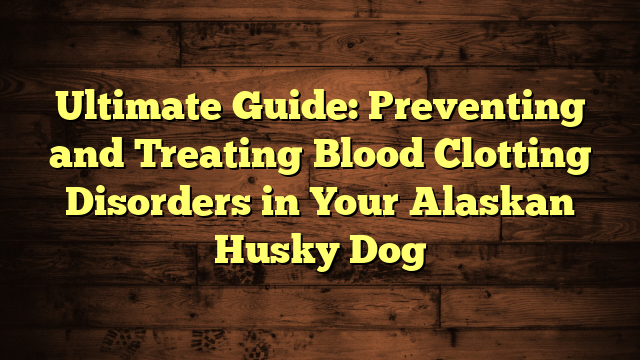
Ultimate Guide: Preventing and Treating Blood Clotting Disorders in Your Alaskan Husky Dog
Learn to successfully stop and deal with blood clotting problems in your Alaskan Husky canine with this final information.
Understanding Blood Clotting Issues in Alaskan Husky Canines
Understanding Blood Clotting Issues in Alaskan Husky Canines
Blood clotting problems in Alaskan Husky canine generally is a critical well being concern. These problems can result in circumstances corresponding to pulmonary thromboembolism, the place blood clots block the circulate of blood to the lungs. This can lead to signs corresponding to speedy respiration, weak pulses, and pale gums. Prognosis of those problems might contain bodily examination, blood testing, and imaging corresponding to chest X-rays or CT scans.
Remedy for blood clotting problems in Alaskan Husky canine might embody anticoagulant drugs corresponding to heparin or warfarin, in addition to anti-platelet drugs like clopidogrel or aspirin. Monitoring and follow-up care are important to handle these circumstances, as they will have a guarded to poor prognosis. It is vital to work carefully with a veterinarian to develop a remedy plan and supply ongoing look after canine with blood clotting problems.
Stopping Blood Clotting Issues
Blood clotting problems may be prevented by taking sure measures to cut back the danger of creating blood clots. That is particularly vital for people who’ve underlying circumstances that will predispose them to clotting problems. Some preventive measures embody:
Common Train
Participating in common bodily exercise may also help enhance blood circulation and scale back the danger of blood clots. Train additionally helps keep a wholesome weight and reduces the danger of weight problems, which is a threat issue for clotting problems.
Wholesome Weight-reduction plan
Consuming a balanced food regimen that’s wealthy in fruits, greens, complete grains, and lean proteins may also help keep general well being and scale back the danger of creating clotting problems. It is vital to restrict the consumption of meals excessive in saturated fat and ldl cholesterol, which might contribute to clot formation.
Avoiding Extended Immobility
Sitting or standing for lengthy intervals of time can enhance the danger of blood clots, particularly within the legs. It is vital to take common breaks to maneuver round, particularly throughout lengthy flights or automobile rides, to forestall clot formation.
Keep Hydrated
Consuming loads of water may also help stop dehydration, which might thicken the blood and enhance the danger of clot formation. Staying hydrated is vital for general cardiovascular well being.
Keep away from Smoking and Extreme Alcohol Consumption
Each smoking and extreme alcohol consumption can contribute to clot formation and enhance the danger of heart problems. Quitting smoking and moderating alcohol consumption may also help scale back the danger of clotting problems.
Handle Underlying Well being Circumstances
People with circumstances corresponding to diabetes, hypertension, and excessive ldl cholesterol ought to work with their healthcare suppliers to handle these circumstances successfully. Correct administration of underlying well being circumstances may also help scale back the danger of creating blood clotting problems.
By incorporating these preventive measures into each day life, people can scale back their threat of creating blood clotting problems and keep general cardiovascular well being. It is vital to seek the advice of with a healthcare supplier for personalised suggestions based mostly on particular person well being standing and threat elements.
Recognizing Signs of Blood Clotting Issues
Blood clotting problems can current with a wide range of signs, relying on the particular situation and the placement of the blood clot. Some widespread signs to look out for embody:
1. Swelling and Ache
Blood clots within the legs or arms could cause swelling, ache, and tenderness within the affected space. The pores and skin may additionally really feel heat to the contact.
2. Shortness of Breath
If a blood clot travels to the lungs, it could possibly trigger shortness of breath, chest ache, and a speedy coronary heart price. This can be a medical emergency and requires rapid consideration.
3. Redness and Heat
Within the case of superficial blood clots, corresponding to these within the veins simply beneath the pores and skin, the affected space might seem purple, heat, and swollen.
It is vital to notice that these signs may also be indicative of different medical circumstances, so it is important to hunt medical recommendation should you expertise any of those indicators. For those who suspect a blood clot, search medical consideration instantly.
Remedy Choices for Blood Clotting Issues
Blood clotting problems in canine, corresponding to pulmonary thromboembolism, require immediate and applicable remedy. The remedy choices for these problems embody:
Anticoagulant Medicines
Anticoagulant drugs, corresponding to heparin and warfarin, are generally used to forestall blood clotting and scale back the danger of future clots. These drugs might should be administered long-term and require cautious monitoring of blood clotting standing.
Anti-Platelet Medicines
Medicines like clopidogrel and aspirin could also be used to forestall blood clots from forming in canine with problems that put them at elevated threat of creating pulmonary thromboembolism.
Thrombolytic Medication
Thrombolytic medication are used to dissolve current blood clots. Nonetheless, their efficient use with out problems will not be clear, they usually might not be generally used within the remedy of blood clotting problems in canine.
It’s important for canine homeowners to work carefully with their veterinarian to find out essentially the most applicable remedy plan for his or her pet’s particular situation. Common monitoring and follow-up are important to make sure the absolute best final result for canine with blood clotting problems.
Care and Restoration for Alaskan Husky Canines with Clotting Issues
Alaskan Huskies are a well-liked breed identified for his or her endurance and power, however they may also be liable to clotting problems. In case your Alaskan Husky has been recognized with a clotting dysfunction, it is vital to offer the required care and help for his or her restoration.
Understanding Clotting Issues in Alaskan Huskies
Clotting problems in Alaskan Huskies may be attributable to a wide range of elements, together with genetic predisposition, underlying well being circumstances, or environmental elements. It is vital to work together with your veterinarian to know the particular reason for the clotting dysfunction in your canine, as this may inform their remedy and restoration plan.
Care and Administration of Clotting Issues
As soon as a clotting dysfunction has been recognized, your veterinarian will probably suggest a remedy plan that will embody medicine, dietary adjustments, and way of life modifications. It is vital to comply with their suggestions carefully and supply a secure and stress-free setting to your canine to help their restoration.
Monitoring and Comply with-Up
Common monitoring and follow-up appointments together with your veterinarian are essential for canine with clotting problems. This will embody blood exams, imaging research, and different diagnostic procedures to evaluate your canine’s progress and alter their remedy plan as wanted.
Prognosis and Outlook
The prognosis for Alaskan Huskies with clotting problems can fluctuate relying on the underlying trigger and the canine’s response to remedy. It is vital to stay vigilant and proactive in managing your canine’s situation to make sure the absolute best final result for his or her well being and well-being.
In conclusion, stopping and treating blood clotting problems in Alaskan Husky canine requires shut monitoring, genetic testing, and common veterinary check-ups. Early detection and applicable medical intervention may also help decrease the danger of blood clotting problems in these canine, guaranteeing their general well being and well-being.






